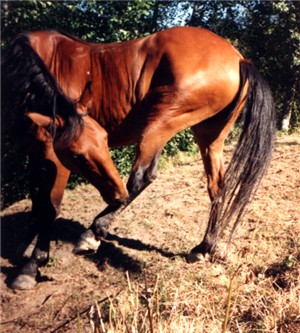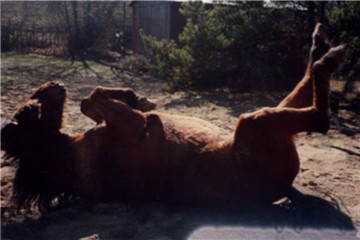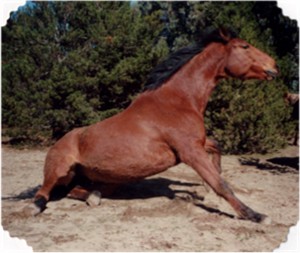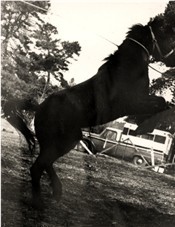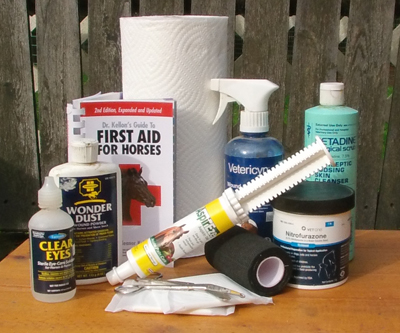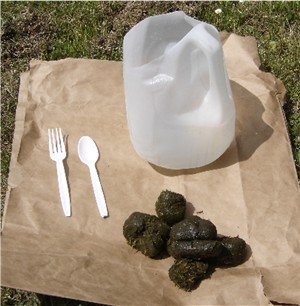Signs of Colic: Learn to Spot 'em Fast
The signs of colic in horses can range from very mild to very severe. Severe cases of colic often start out with very mild symptoms that quickly progress to a very painful life threatening case of equine colic. Equine colic is an emergency. It is important to recognize signs so you can take action quickly.
Colic Symptoms
- Pawing the ground
- Horse kicking at their stomach
- Getting up and down
- Horse keeps looking at their flanks
- Nipping at their belly
- Rolling
- Lying on their back
- Constipation
- Abnormal posture – saw horse stance, sitting like a dog, hunched back
- Sweating
- Rapid heart rate
- Rapid breathing
- Increase in gut sounds
- Absence of gut sounds…very serious
Making Sense of Signs of Colic
A horse will show only a few signs of colic at any given time and bouts of pain from colic can be intermittent. If you suspect your horse is showing any signs of colic watch them closely. Be patient. This is not the time to leave your horse alone. Watch your horse very closely to see if the symptoms seem to be going away or worsening.
If your horse is showing signs of abdominal pain…DO NOT LET THEM ROLL
Put a halter on your horse and walk them around. This will help in two ways. Walking encourages movement of the bowls. If a horse is constipated or impacted the simple act of walking can encourage the obstruction to pass. Keeping your horse and up on his feet will prevent him from rolling. A horse that has colic due to a sand impaction can literally twist their bowls. It’s called a twisted gut and it is deadly.
Horses can show signs of colic when they only have a mild case of constipation, but the very same signs can be the early warnings of something much more deadly like a ruptured bowl. If your horse does not show obvious signs of improvement or the symptoms begin to worsen, get your horse medical treatment immediately. The faster colic is recognized and treated, the better the chances for a happy ending.

Treatment for Colic in Horses
Unless you specifically know why your horse is suffering from colic, like grain overload or exposure to green grass, it will be up to your veterinarian to determine the cause. Treatments for colic vary accordingly.
If the horse is suffering from a distended gas filled stomach, the vet may relieve the pressure with a stomach tube that will allow the gasses to escape. He will perform a rectal exam to determine if there is any intestinal blockage or distended bowls. Horses that have ingested too much grain will be given large doses of mineral oil via a stomach tube to prevent the digestion of the grain. The objective is to have the grain pass as quickly as possible to prevent laminitis. Magnesium sulfate is sometimes used for sand colic.
Colic caused by intussusception, most common in young foals, will require immediate surgery. Newborn foals can also fail to pass the meconium (first stool in newborns) causing an impaction colic. This can often be solved with an enema and a dose of mineral oil. A vet should always be consulted when dealing with colic in a foal.
If the horse is suffering from an obstruction due to a foreign object or twisted gut, x-rays may be necessary. Horses suffering sever pain will be give pain killers to offer relief and keep them from seriously injuring themselves. They may be given an IV for treatment of shock. Many cases of horse colic can be resolved with mineral oil and enema’s, but those that cannot, will require surgery.
To prevent life threatening damage to the intestinal tract and/or equine laminitis it is imperative that colic be spotted and treated in a timely manor.
More on Colic
Horse First Aid Kit
Find out what items you need to build a well rounded horse first aid kit for your barn, your truck and on the trail.
Do you know someone who could use this information? Please share it using the buttons below.
Return to top of Signs of Colic page to easily access the navigation bar on the left for more at Equinespot.com
